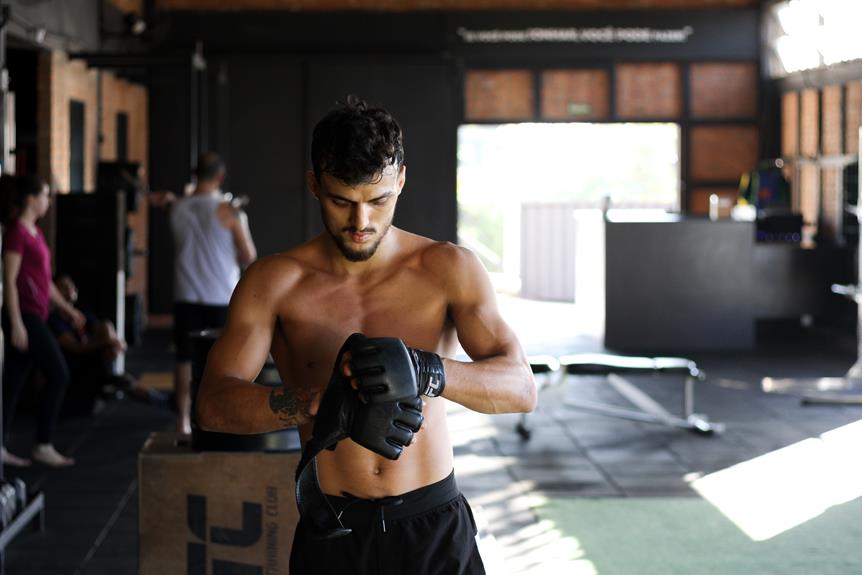In the ever-evolving world of UFC, the age of fighters in the top 15 of each division has become a topic of intrigue. Recent analysis reveals that as of 2024, the average age of these fighters stands at 32.3, demonstrating a noteworthy increase of 1.3 since 2017.
By delving into each weight class individually, we discover that the average ages range from 30.3 in the Flyweight division to 33 in the Women's Bantamweight division. These findings provide valuable insights into the shifting dynamics of the sport, shedding light on the changing landscape within each weight class.
Key Takeaways
- The average age of UFC fighters in the top 15 rankings has increased by 1.3 years since 2017.
- Different weight class divisions have varying average ages, with lighter divisions like flyweight and women's flyweight having a relatively younger average age, emphasizing speed and agility.
- The heavyweight division stands out with the oldest average age, as power becomes more crucial and fighters retain their strength as they age.
- Factors such as improved nutrition, training techniques, and dedication to physical fitness and overall health contribute to extended careers in UFC.
Flyweight: 30.3
Among the UFC fighters in the top 15 of the flyweight division, the average age stands at 30.3, reflecting a youthful and competitive roster.
This statistic raises the question of how age impacts the performance of flyweight fighters. In combat sports, particularly in the lighter divisions, speed and agility are crucial factors for success. Younger fighters tend to possess these attributes in abundance, allowing them to excel in the flyweight division.
However, it is important to note that experience and technical skills also play a significant role in a fighter's performance.
Comparing the average age in the flyweight division across different combat sports organizations would provide valuable insights into how age affects the competitiveness and talent pool in this weight class.
Bantamweight: 31.3
The average age of bantamweight UFC fighters in the top 15 of the division is 31.3, indicating a relatively youthful roster with a mix of talent and experience. Here is a discussion of two important aspects related to this subtopic:
- Impact of weight cutting on bantamweight fighters:
- Bantamweight fighters often engage in weight cutting to make the lower weight limit for the division.
- This practice can be physically demanding and potentially affect their performance and health.
- It is crucial for fighters to have a well-planned weight-cutting strategy to ensure optimal performance inside the octagon.
- Notable bantamweight fighters and their fighting styles:
- TJ Dillashaw, a former champion known for his technical striking and footwork.
- Petr Yan, a rising star with explosive striking and relentless pressure.
- Aljamain Sterling, a well-rounded fighter with a strong grappling game and submission skills.
Understanding these aspects contributes to the appreciation and analysis of the bantamweight division in the UFC.
Featherweight: 32.2
Interestingly, featherweight UFC fighters in the top 15 of the division have an average age of 32.2, indicating a slightly older roster compared to the bantamweight division. This age trend could be attributed to the fact that featherweight fighters have typically been in the sport for a longer period of time, accumulating experience and honing their skills.
It is also worth noting that featherweight training techniques often emphasize speed, agility, and precision, as these qualities are crucial for success in the division.
As for featherweight title contenders, fighters such as Alexander Volkanovski, Max Holloway, and Brian Ortega have proven themselves to be formidable opponents, displaying a combination of technical skill, athleticism, and strategic prowess.
With the average age of 32.2, the featherweight division continues to showcase the talents of experienced fighters who are capable of delivering thrilling performances inside the octagon.
Lightweight: 32.75
With an average age of 32.75, the lightweight division in the UFC showcases a group of fighters who are in the prime of their careers and possess a unique combination of skill, experience, and athleticism.
The age trends in the lightweight division reveal that fighters in this weight class tend to be slightly older compared to their counterparts in the lighter divisions. However, age does not seem to have a significant impact on lightweight fighter performance.
These fighters have honed their skills over the years and have gained valuable experience inside the octagon. They have a deep understanding of the technical aspects of the sport and are able to execute complex strategies with precision.
Additionally, their athleticism allows them to maintain a high pace throughout the fight, showcasing their speed and agility.
Welterweight: 32.1
In examining the welterweight division of the UFC, it is evident that the average age of fighters in the top 15 is 32.1, indicating a group of experienced and seasoned athletes at the peak of their careers. This age range suggests that these fighters have likely honed their skills over many years, making them formidable opponents in the octagon. The impact of age on welterweight fighters can be significant, as they need to balance their physical abilities with their accumulated knowledge and experience. Strategies for welterweight fighters at different age ranges can vary, with younger fighters often relying on their athleticism and speed, while older fighters may rely more on their wisdom and fight IQ. Let's take a look at the table below for a better understanding:
| Age Range | Strategies |
|---|---|
| 25-30 | Utilize speed and agility to overwhelm opponents |
| 30-35 | Combine physical abilities with technical skills |
| 35-40 | Leverage experience and fight IQ to outsmart opponents |
| 40+ | Adapt and adjust their game plan to compensate for declining physical attributes |
These strategies can help welterweight fighters maximize their performance and stay competitive in the ever-evolving world of mixed martial arts.
Middleweight: 32.9
The average age of UFC fighters in the top 15 of the middleweight division is 32.9, indicating a group of experienced and seasoned athletes competing at a high level in their careers.
Middleweight fighters, with their average age slightly above the overall average of 32.3, demonstrate the impact of age on fighter performance.
Comparing the age trends with other weight divisions, it is clear that middleweight fighters tend to be slightly older than their lighter counterparts. This could be attributed to the fact that as fighters move up in weight, they tend to gain more muscle mass and size, which takes time to develop.
Additionally, the middleweight division is known for its technicality and strategic approach, where experience and knowledge play crucial roles in achieving success.
Therefore, the higher average age in the middleweight division reflects the importance of maturity and fight IQ in this weight class.
Light Heavyweight: 33.1
Boasting an average age of 33.1, the light heavyweight division showcases a group of seasoned UFC fighters at the top of their game. This age is slightly above the overall average of 32.3 for all weight divisions.
The impact of age on light heavyweight fighters is unique due to the division's emphasis on power. While speed may decline with age, fighters in the light heavyweight division are still able to maintain their power, making experience and technique crucial in their success.
When comparing the average age of light heavyweight fighters to other divisions, it is clear that they tend to be slightly older. This can be attributed to the physical demands of the division, which require fighters to develop strength and power over time.
Nevertheless, these experienced fighters continue to make their mark in the octagon.
Heavyweight: 33.4
With an average age of 33.4, the heavyweight division showcases a group of experienced and powerful UFC fighters at the top of their game. These fighters have honed their skills over the years, combining their physical strength with technical prowess.
However, fighter age and retirement decisions play a significant role in the heavyweight division. As fighters age, they may face challenges in maintaining their physical abilities and recovering from injuries.
The impact of age on heavyweight fights can be seen in several aspects:
- Endurance: As fighters get older, their stamina may decline, affecting their ability to go the distance in grueling heavyweight bouts.
- Speed: While power is crucial in the heavyweight division, speed can still make a difference in landing effective strikes and evading opponents.
- Recovery: With age, fighters may find it harder to recover from injuries, which can limit their training and performance in fights.
Given these factors, it is important for heavyweight fighters to carefully consider their age and retirement decisions to ensure they compete at their best.
Women's Strawweight: 32.9
How does the average age of 32.9 impact the competitiveness of the women's strawweight division in the UFC?
The average age of 32.9 in the women's strawweight division suggests that fighters in this weight class tend to be slightly older compared to other women's divisions in the UFC. This can have both positive and negative implications for the competitiveness of the division.
On one hand, the experience and maturity that comes with age can contribute to a higher level of technical skill and fight IQ among the fighters.
On the other hand, the physical attributes and athleticism that are often associated with youth may start to decline as fighters get older, potentially impacting their performance in the octagon.
It is worth noting that the average age of 32.9 is still within the new UFC prime age range of 30 to 35, which suggests that the fighters in the women's strawweight division are still capable of delivering exciting and competitive fights.
However, it may be interesting to monitor the division as younger fighters start to enter the mix and see if they can bring a new level of energy and dynamism to the division.
Women's Flyweight: 31.3
The average age of fighters in the Women's Flyweight division, at 31.3, is indicative of the diverse range of experience and skill levels present in this weight class. Age trends in the women's flyweight division can have an impact on fighter performance, as fighters at different stages of their careers bring different strengths and weaknesses to the octagon.
Here are three key points to consider:
- Youthful exuberance: Younger fighters in their early twenties may possess raw athleticism and agility, enabling them to utilize their speed and quickness to their advantage.
- Peak performance: Fighters in their late twenties and early thirties often have a combination of physical strength, technical abilities, and fight experience, making them formidable opponents in the flyweight division.
- Veteran expertise: Seasoned fighters in their mid-thirties or older bring a wealth of knowledge and fight IQ, allowing them to rely on their experience and strategic approach to overcome any physical decline.
Women's Bantamweight: 33
At an average age of 33, fighters in the Women's Bantamweight division showcase their experience and resilience in the octagon. Age plays a significant role in the performance of athletes in combat sports, and the impact of age in the Women's Bantamweight division cannot be overlooked.
There are several factors that influence the average age in this division. Firstly, the longevity of female fighters in the UFC has increased over time, allowing them to compete at a higher level for a longer period. Additionally, the development of training methods, nutrition, and recovery techniques has enabled fighters to maintain their physical abilities and prolong their careers.
Lastly, the increased popularity and talent pool in the division may also contribute to the higher average age, as more experienced fighters continue to compete. Overall, the average age of 33 in the Women's Bantamweight division reflects the maturity and skill of these fighters.
Average Age of UFC Fighters in Each Division
Across all weight class divisions, there is a notable variation in the average age of UFC fighters. The impact of age on fighter performance is a significant factor to consider in the world of mixed martial arts. The age trends in the UFC top 15 rankings shed light on the age distribution among the fighters.
Here are three key observations regarding the average age of UFC fighters in each division:
- The lighter divisions, such as flyweight and women's flyweight, have a relatively younger average age, with fighters in their early 30s. This could be attributed to the emphasis on speed and agility in these weight classes.
- The middleweight and light heavyweight divisions have fighters in their early to mid-30s, indicating a balance between speed and power. These divisions require a mix of both attributes for success.
- The heavyweight division stands out with the oldest average age, with fighters in their early 30s to mid-30s. As power becomes more crucial in this division, fighters tend to retain their strength as they age.
Understanding the age trends in the UFC top 15 rankings provides valuable insights into the dynamics of fighter performance across different weight classes.
Age Trends in UFC Top 15 Rankings
Given the average age of UFC fighters in the top 15 of each weight class division, it is evident that age trends play a significant role in the rankings. The fighter age distribution in the top 15 rankings ranges from 30.3 to 33 years old, with the average age across all divisions being 32.3. This suggests that fighters in their early 30s are more likely to achieve higher rankings.
It is important to note that the new UFC prime age is considered to be between 30 and 35 years old. This age range is ideal for fighters as they possess a balance of experience, physicality, and skill. Additionally, it is observed that in the lighter divisions, speed is prioritized, while power becomes more important in the heavier divisions. This implies that fighters tend to retain power more than speed as they age, which can impact their rankings.
Impact of Age on Fighter Performance
As fighters age, their performance in the octagon can be influenced by various factors. Here are three key impacts of age on fighter performance:
- Physical Decline: Aging fighters often experience a decline in their physical abilities, such as decreased speed, agility, and endurance. This can make it more challenging for them to execute their techniques effectively and maintain a high pace during fights.
- Injury Susceptibility: Older fighters are more prone to injuries due to the wear and tear their bodies have endured over the years. This can result in longer recovery times and a higher likelihood of recurring injuries, which can hinder their training and performance.
- Adaptation and Strategy: Aging fighters need to adapt their fighting style and develop new strategies to compensate for their diminishing physical attributes. This may involve focusing more on technique, utilizing experience and fight IQ, and conserving energy for crucial moments in the fight.
To overcome these challenges, strategies for aging fighters may include smart training methods, injury prevention measures, and a focus on mental strength and game planning. It is essential for fighters to understand and accept the impact of age on their performance and make necessary adjustments to continue competing at a high level in the UFC.
The Prime Age Range for UFC Fighters
The optimal age range, typically referred to as the prime age, for UFC fighters is between 30 and 35 years old. This age range is considered to be the peak of physical performance and mental acuity for most athletes.
When analyzing the impact of age on fighter performance, there is a correlation between age and ranking in the top 15 of each weight class division. The average age of UFC fighters in the top 15 ranges from 30.3 to 33 years old.
It is interesting to note that the average age has increased by 1.3 years since 2017. This suggests that fighters are able to maintain their peak performance for a longer period of time.
However, it is important to consider that individual fighters may have different trajectories and may reach their prime at different ages.
What Is the Age Limit for MMA/UFC Fighters in 2024?
The age limit for MMA/UFC fighters in 2024 will depend on the specific regulations set by the governing bodies. These mma/ufc age limits are put in place to ensure the safety of the fighters and to prevent potential health risks associated with competing at an older age. It is crucial for organizations to strike a balance between allowing experienced fighters to continue their careers while prioritizing their well-being. Over time, these age limits may evolve and adapt as the understanding of fighter safety advances.
Conclusion
In conclusion, the average age of UFC fighters in the top 15 of each division has steadily increased over the years, with the current average age standing at 32.3 in 2024. This trend highlights the evolving dynamics of the sport and the changing landscape within each weight class.
As fighters age, certain attributes like speed and power become more crucial, with power being retained more than speed. Overall, these findings provide valuable insights into the age trends and performance dynamics of UFC fighters.
- 15 Best Martial Arts Weapons (Fighting & Training) - October 14, 2024
- Is Fencing a Martial Art? (Yes, 4 Reasons Why) - October 14, 2024
- 7 Best Martial Arts for Self-defense Ranked (Highly Effective) - October 14, 2024










